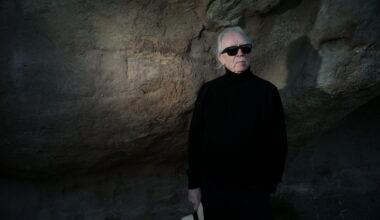The first weekly Independent Chart was published on 19 January 1980. We talk to Cherry Red’s Iain McNay and Rough Trade’s Geoff Travis, the instigator and the catalyst, about how punk rock and a garden shed ignited the indie label revolution
Punk was the storm that broke. The rain that finally fell after that long, speed-addled summer of 1977 proved nourishing. The anarchic, provocative, art school thinking that had sprung out of Malcolm McLaren and Vivienne Westwood’s King’s Road base flourished and withered at a shocking and exhilarating pace. Yet, even as the Sex Pistols’ camp were busy immolating their own accomplishments, there was – hidden beneath a sheen of nihilism – a sense of possibility infecting the nation’s youth.
“This is a chord. This is another. This is a third. Now form a band” so challenged the iconic Sideburns fanzine, but it could have said the same about becoming an artist or fashion designer, opening a shop, managing a band, printing zines, or as is crucial to this conversation, forming an independent label. Everything, it seemed, was up for grabs by anyone.
In Manchester, Richard Boon’s New Hormones label had released the first Buzzcocks single, ‘Spiral Scratch’, in January 1977. Martin Hannett, operating under the peak-punk pseudonym of Martin Zero, manned the desk. It sold 1,000 copies in a matter of weeks, quickly recouping the £500 that the band had scraped together from friends and family in order to fund it.
“That was interesting because it was right at the beginning of that era,” says Cherry Red’s Iain McNay, then general manager for Magnet Records. “Independent labels were just starting to get visibility, and people were really excited because it was something new. They just wanted to support it, somehow. People were buying records they hadn’t even heard.”
‘Spiral Scratch’ would eventually shift 16,000 copies via mail order and the support of the local Virgin Records. Like the much-vaunted Pistols gig at the Manchester Free Trade Hall, which had proven a damascene moment for the likes of Tony Wilson, Ian Curtis, Morrissey and Mark E Smith (as Stephen Morris once eloquently put it, “even people who weren’t there, were there!”), the effects of ‘Spiral Scratch’ would continue to reverberate in a big way. Its look, its sound and its accessibility all pointed a way forward. A call to action.
Prior to his role running Magnet, Iain McNay had spent some years working for Arista Records and he’d felt there was something in the air for a while. In the spring of 1978, having first become aware of the idea of independent singles via The Desperate Bicycles’ somewhat wobbly ‘Smokescreen’ released the previous August, he founded his own label, Cherry Red Records.
“Things had started to change,” says McNay. “I remember seeing the New York Dolls play the first time they came to London in the early 70s. It was at a club called Biba’s, which was quite posh – you had to have steak and chips first and then the New York Dolls came on! I think that was the first time Malcolm McLaren saw them. They weren’t punk, but it was the beginning of things moving in that direction.”
McNay had seen Patti Smith and Lou Reed come through the Arista doors, so had established a feel for the new US bands that would be his making but, by 1978, he was already ensconced in a good job at Magnet.
“Magnet were under independent ownership, but it wasn’t ‘independent music’. It was people like Darts and Chris Rea. It wasn’t my music,” he says. “But I saw this opportunity created by punk and I thought, ‘Here’s a chance to start my own label’. So I resigned from Magnet and started Cherry Red knowing that I would make it… or I wouldn’t.”
McNay, like many others, realised that the majors were only capable of identifying and signing so much. The biggest bands – for all of their ideals – went to the biggest labels. The Sex Pistols had collected major label advances like dole cheques before they were deemed untouchable, The Clash had gone to CBS, the Banshees to Polydor.
“There were hundreds, if not thousands of bands of that era who couldn’t get deals,” says McNay. “And a lot of them were really good and would sell a few thousand records.”
McNay’s first release, the hammering, Jonathan Richman-esque ‘Bad Hearts’ by The Tights, coincided with the emergence of the colour sleeve. The seven-inch packaging went from being a boring bag to a blank slate.
“We had to get the labels, the sleeves and the vinyl all done at different places,” he says. “It was real DIY. You’d invite a few mates round, get a couple of bottles of wine and some beers and then set to work putting the records in the sleeves.”
From facing a few, very large, very shut doors, the state of play for independent artists was transformed. Across town, a record shop had sprung up in a cheap unit off the Portabello Road. Dreamt up by former drama teacher Geoff Travis, the shop was inspired by the stores he had encountered on his travels in the US. Rough Trade was designed to be a shop that was “more than a place to buy things”. A questionable model for a retailer, but Travis had seen the idea in action at San Francisco’s City Lights book store, and he’d amassed a considerable haul of secondhand stock on that same road trip. In 1977, after a quiet six months, word got around and the shop became a hotbed of independent activity.
“Rough Trade was the kind of place where you’d always met somebody interesting,” says McNay. “It was fairly manic and appeared to be disorganised, but it was actually reasonably well-organised. It was new and exciting and you felt like it was something that hadn’t happened before. There was a coming together of kindred spirits and those kindred spirits, ultimately, wanted to buy records that were different. And a lot of them saw the way to do that was not so much directly, but by starting their own labels.”

By luck or design, within the first few years of that growing independent scene, Rough Trade became an essential hub for indie labels, bands and fans.
“I suppose by then, the shop was a pretty exciting place to be,” says Geoff Travis. “We bought these secondhand sound system speakers from some shady people up in Harlesden, and we put them in the shop. It was really powerful, with lots of bass, so our main joy was just going to work and playing records really loudly. At weekends, the shop got really crowded, on Friday and Saturday you often couldn’t even get in the door. We’d have the locals coming in and people arriving from different towns in the UK. We’d also have lots of ex-punks, post-punk people, bands, musicians, giving us their tapes.”
Like Cherry Red, Rough Trade set up their own label in 1978, releasing Parisian punks Métal Urbain’s second single ‘Paris Maquis’. The shop had also started to distribute imports and purchases direct from indie bands and labels, serving a network of stores – an operation they ran out of a shed at the back of the shop on Kensington Park Road. Mark Perry would staple up Sniffin’ Glue in that same shed. The Specials – seven of them, by Travis’ recollection – all piled in for a meeting once. The Smiths, Cabaret Voltaire, Scritti Politti, The Bluebells, The Rezillos and far more would filter through the premises. By the time the post-punks and synth experimenters started arriving, the dots were practically joining themselves. Music writer Jon Savage had first started frequenting the store to shift his London’s Outrage fanzine and it was his Sounds piece on Cabaret Voltaire that brought the band to Rough Trade’s attention.
“He wrote an amazing review of their first EP, ‘Do The Mussolini (Headkick)’,” says Travis. “So Jon really alerted us to the Cabs. We got to know them and we signed them up, as it were. Then famously, Daniel Miller came in with ‘TVOD’, which we played over the sound system, these reggae speakers. Jane Suck was in the shop, who at that time was quite an infamous journalist for Sounds, and she rushed up to the counter and said, ‘What is this?’. That was a good reaction, Daniel was very happy and we encouraged him to press up the record and said we’d buy loads of copies. So that helped get him started.”
It was the simplicity of the idea that made it such a good one. If you were a band or label with something you wanted to get out there, you would take it to Rough Trade. If they liked it, they would shift it to the shops in their network – the likes of Red Rhino in York, Probe in Liverpool or Revolver in Bristol – which was soon dubbed The Cartel.
“We were very, very open,” says Travis. “That was the whole point. It was meant to get rid of all those barriers of entry. Back then, the music industry seemed like a behemoth that was unreachable to any normal people. The whole point about punk, for us, was to get rid of all that.”
It must have been nerve-wracking though, being a kid in Miller’s shoes, talking to the gatekeepers of this new world.
“I think people were probably a bit nervous,” says Travis. “But you know, everyone’s different. I never went into Malcolm and Vivienne’s shop on King’s Road. I was just a suburban kid from Finchley. Daniel said he was nervous, but he didn’t appear that nervous. I suppose the shop’s reputation by then was burgeoning, so maybe you might have felt you were a bit uncool. You don’t feel secure in your tastes as a teenager. You always think someone’s going to trip you up and sell you a Buggles single.”
Thanks primarily to the punk boom, the indie world was thriving and, at the turn of the decade, had already broken into the mainstream at points. Stiff Little Fingers’ 1979 debut ‘Inflammable Material’, released by Rough Trade, reached Number 14 in the charts, becoming the first independently released record to sell over 100,000 copies. That same year, Iain McNay had invested 10 grand of Cherry Red cash in order to fund the Dead Kennedys’ debut ‘Fresh Fruit For Rotting Vegetables’ – and was feeling pretty good about their prospects. All over the country, labels were popping up and filling gaps the majors weren’t even aware existed: Factory in Manchester, Postcard in Glasgow, Fast Product in Edinburgh, Small Wonder, Beggars Banquet and 4AD in London, 2 Tone in Coventry. It was becoming clear that this was more than a spark that would flare up and burn out with punk itself.
It was around this time that the idea for an indie-only chart first struck Iain McNay. The mainstream Top 75 was dominated by major label acts. This was, obviously, thanks in significant part to the mass appeal of the artists, but also the majors’ marketing spend, their tight relationships with TV and radio and their sale-or-return policy with chain store stockists. What’s more, there were those in the indie community alleging that the lower reaches of the chart were influenced – at key stores – by major label reps who hoped to increase the chances of their dustier acts breaking into the Top 75.
This mattered in the cycle of commerce: store orders nationwide were in-turn influenced by the official chart, so even gaining a low placement made a difference to an indie label’s fortunes. Hit the Top 75 and big stores like Woolworths would stock you by default, as would many of the land’s jukeboxes.
“I remember around that point we had out our first Dead Kennedys single, ‘Holiday In Cambodia’, and it sold truckloads,” says McNay. “In the [industry trade paper] Record Business chart, it was in their Top 100, but in the official chart it didn’t make the Top 75. That was hugely frustrating because I felt it was selling as well as many of the records that were in there. It was then that I realised there was a grave injustice in the chart.”
Simultaneously, McNay had started to clock independent stores and distributors running adverts in the music press featuring their own indie Top 10s. He knew some people at Record Business and discovered that they compiled their own Top 100 chart figures.
“They tended to phone shops direct to get sales figures and prided themselves on having a more accurate chart,” says McNay. “There was no real chart that covered what was quite a vibrant scene, so I said, ‘Look, you’ve got the figures, why don’t you just run a chart that features records with independent distribution?’. They said, ‘Oh, that’s a good idea’. And they ran the first one in January 1980 and, of course, quite famously, Number One was Spizzenergi with ‘Where’s Captain Kirk?’. I think Spizz has dined out on that ever since! He was Number One for the first seven weeks, so he had a good run.”
“I suppose I became aware of the Independent Chart straight away, really,” says Travis. “It helped because it gave a bit of an indicator as to what other shops should order. It was like a sell sheet. It really helped the Rough Trade distribution to say, ‘These are the popular records’. It was a good innovation, I give Iain great credit for that. It was also a good way of being depressed when you’d see the whole thing dominated by UK Subs.”
The Independent Chart was the final piece in the puzzle, fitting alongside several indie support networks, including John Peel’s essential radio shows, The Cartel and the loose affiliation of indie labels that would many years later formalise and become the Association Of Independent Music (AIM).
“It was just something else we could do to support independent labels,” says McNay. “We could really show a licensee in Germany that we had a Number Three hit in the Independent Chart and that meant something to them. It helped with radio, to some extent – obviously, people like Peel and Mike Read knew their stuff – but if a record was high in the Independent Chart and playable on daytime radio, it would encourage some of the daytime shows to actually play it. It helped independent records to get more exposure, which I think was a positive thing.”

While the artists in the new independent scene could be relied upon to be less than accommodating with one another (“There was no collegiate vibe,” Edwyn Collins memorably told us last year. “Everybody hated everybody and you took almost as much pleasure at another band’s failings as your own success”). Yet, strangely, between labels, the relationships were far more cooperative.
“There used to be about 15 or 20 of us who would meet up every few weeks and just exchange ideas,” says McNay. “It was about supporting each other, because it was tough being an independent label. It wasn’t easy.”
“There was a great deal of camaraderie and protectiveness between all the labels,” agrees Travis. “I think that was a really good part of what was going on in those days.”
The Rough Trade man remains cagey on salacious details, but relates experiences of talking artists out of signing to majors, or warning Daniel Miller at Mute that someone was trying to poach one of his acts. There were rivalries, but they were distinctly friendly.
“The worst one was when the Swell Maps album came out on the same day as Joy Division,” says Travis, recalling a conversation with friend and Factory Records founder, Tony Wilson. “I remember saying ‘We’re ahead of you, Tony. We’re selling more copies!’. That didn’t last long…”
Looking back, 1980 seems to have contained so many significant events in indie and electronic music. The chart launched in January. Ivo Watts-Russell and Peter Kent established what would become 4AD. Ian Curtis took his own life in May. Daniel Miller – now running Mute – caught Depeche Mode supporting his first signee Fad Gadget and snapped them up. In September, Cherry Red had its biggest hit as the Dead Kennedys’ album came good. In October, New Order added Gillian Gilbert to their line-up. It was a point at which the indie world found itself – and from where the mega indies that came to define the latter part of the decade would start to grow. Rough Trade found themselves all over that first Independent Chart, with 10 of the Top 30 singles and five of the Top 15 albums.
“Not to be arrogant,” says Travis, signalling some, er, well-earned arrogance. “But I think we expected our records to be in there. Honestly, we were so lucky. I mean, Johnny Marr came down to play ‘Hand In Glove’ to me. Rough Trade wouldn’t necessarily be first port of call now, but there was a moment during those years where being independent meant being distributed by Rough Trade.”
Boom times would follow as the indies got more ambitious. By 1983, Rough Trade had picked up The Smiths (after they were turned down by EMI), Depeche Mode conquered the pop world without leaving Mute, New Order unleashed ‘Blue Monday’ and, somewhat unwittingly, funded The Haçienda. The new indie support network no doubt played its part, but why does Travis think those particular artists enjoyed such a meteoric rise?
“I think the most intelligent musicians understood the concept of post-punk and of social liberation and didn’t want to be part of the mainstream system,” says Travis. “They could see the logic of it. Depeche Mode could see the logic of staying with Daniel. They got a better return than they would from the major and they had the freedom and also they had Daniel’s A&R support, someone that understood them and electronic music in a way that they just wouldn’t have had a major. The relationship between an artist and their company is critical. You see it in book publishing: editors have really interesting creative relationships with their authors, and all the best writers will tell you they love having a good editor.”
The major label system operates on different terms to this day.
“Who’s on Atlantic Records today?” says Travis. “Tell me three great Atlantic artists.”
At this point in our roaming conversation, I am rendered uncharacteristically quiet.
“You can’t think of any, can you?”
Well, no…
“And that’s what I mean. We have a concept where each project has its own logic. If we can break even, then it can continue and do more. Whereas a major, if it doesn’t sell a certain number of units, it’s a complete and utter waste time.”
Of course, the problem with Travis’ logic, shared by many of the indies, was that the bottom line could be somewhat, well, wavy. The hits were hard to predict and were usually outweighed by the misses. At the turn of the 1980s, many of the indies were struggling to manage the kind of vast cash flows, distribution requirements and general administrative savvy called for by the very sizeable success stories they had created.
“It was a difficult world,” says McNay. “There are only three companies left from the late 70s that have maintained independence all that time. There’s Ace, which started as Chiswick, but is the same company. There’s Beggars [Group – which now own 4AD, Rough Trade et al] and there’s Cherry Red. There’s only three left”
By 1991, Rough Trade’s label and distribution wing was, somewhat surprisingly, bankrupt.
“Rough Trade’s whole operation went down when they had their biggest success,” says McNay, in lament. “They were distributing KLF, they had the Mute acts and then they had The Smiths, but they couldn’t manage their cash flow. It was tough – first, surviving, and then when you got success, because in terms of turnover the figures were so much greater, and you had to manage that.”
“I mean, I’m really not that great at running a business,” offers Travis, putting it much more succinctly. “I just like music.”
Cherry Red toughed it out, thanks in part to McNay’s savvy (some accountancy training that he probably didn’t brag about in the late 70s ultimately proved one of his best assets). But even so, it was still hard going. The success of the flagship indie artists had not gone unnoticed in major land. The sharks were beginning to circle. Acts were poached and even the Independent Chart – once a hallmark of all that was good and true in music-making – was compromised.
“By the 1990s, major labels were starting their own so-called boutique labels and putting them through independent distributors so they were eligible for the Independent Chart,” explains McNay. “It all became a bit silly. On the one hand, they’d recognised how important the Independent Chart was, but on the other hand, it was disappointing that they were, in effect, cheating.”
The chart then became a bit of a farce until the late 90s, when the rules were tweaked to stipulate that artists had to be on a label that was at least 51 per cent independently owned.
“The first 10 years was the most exciting, musically, and it was also when the chart had the most impact, it was most important in terms of the statement and promotion,” says McNay. “Now, I think all charts have lost their impact since things have gone online. There’s a value in the Independent Chart and I know artists still like to see themselves in there, but the world has moved away from charts now.”
Those looking for the legacy of the indie chart will find it in the modern proliferation of DIY releases and small labels – a raft of which you’ll regularly find on these very pages. It’s heartening to see the mentality that was established by the publication of the very first Independent Chart in January 1980 remains prevalent in contemporary musicians and labels, instilling a set of values that, for better or worse, still considers creative control to be the ultimate asset.
“It does go back to the spirit that was around in the late 70s and early to mid 80s,” says McNay, as our conversation draws to a close. “There was a feeling of wanting to support each other, that we were doing something that had not been done before, something that was important.”






